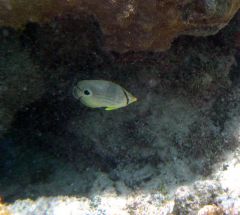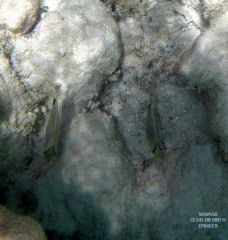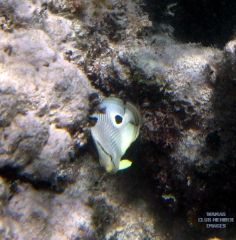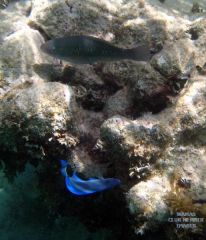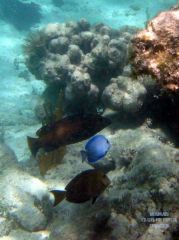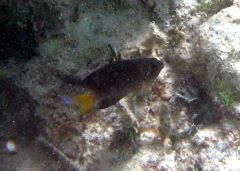
Rascal
BB Participant-
Posts
1,355 -
Joined
-
Last visited
Content Type
Profiles
Forums
Gallery
Events
Store
Everything posted by Rascal
-
I am hardly a veteran, but if that is not a typo . . . . slow your flow! Most recommend 1 - 2L per hour, not minute. Flow per min should be measured in ml. 40 ml/min might be a good # to start with. In other words, a drip. You are probably just blowing CO2 right through the reactor right now without lowering the PH inside the reactor very much. This thread might be helpful: http://www.wamas.org/forums/index.php?showtopic=12934&hl Or just skip to the link for the calculator: http://home.comcast.net/~jdieck1/reactor.html Good luck.
-
Depends on the anenome. The sting of a healthy BTA is enough to make a fish not want to repeat the experience, but not strong enough to kill most fish. Carpets are another story though. They can and do kill and eat small fish. Kind of like the difference b/n a copperhead and a cobra.
-
If you have a canopy, you bring your return plumbing over the top of your tank and then stick the outlets of the scwd in the tank with nothing attached. This would be my recommendation. I have tried glueing locline fittings onto the outlets but they never held for very long. If you want to run your return through a bulkhead, you could still have the scwd in the tank but i wouldn't recommend it because it is so big. Another option would be to use 2 bulkheads, and have the scwd outside of the tank, with one of the outlets going to each bulkhead. They are really made to use vinyl tubing, so you will need hosebarb fittings on the bulkheads, and don't forget the hose-barb clamps! A smear of silicone helps prevent leaks too. If the scwds had threaded fittings, so you could incorporate union ball valves into your plumbing, they would be much easier to work with. For the life of me I can't figure out why they never came out with this simple modification (or the 1 inch size, for that metter). One thing to keep in mind with the scwd is that sooner or later, you WILL have to take it offline to clean it. When the gears get something in them they stop turning and the flow gets stuck on one side. This is what makes it tricky to plumb it pump - scwd - bulkheads. When you take the scwd off (or if it leaks), the water will drain down to your bulkheads.
-
I agree that it is a type of sponge. I have several of these in my system. Every once in a while they will release a bunch of spores - which look like little tiny fuzzy balls. Pretty cool. Sponges help you filter your water -- take in a lot of nutrients. This is a good thing. I guess majanos and ataipsa do too, but unlike the anenomes these don't harm anything and won't reproduce to the extent that they threaten to take over your tank.
-
Here's why I would recommend both a TDS meter and the DI part of a RO/DI system: At some point you will be run into a problem, one of the possible causes of which is excess nutrients, and you will be asking yourself, "Is it my source water?" If you have a good water purification system and you know you are only adding 0.0 TDS water, you can eliminate this as the cause of your problem and move on to other possibilities. Or maybe that's just me. You might not have any problems at all.
-
Pepprmint shrimp / Majanos / Joes Juice
Rascal replied to alan mcilvried's topic in General Discussion
LOL. I'm not sure that Kevlar, with or without Sappi plates, would have oferred Outlaw much protection. Better go to MOPP level 3 at least. -
Best article I have ever read for correcting calcium / alkalinity problems, by Randy Holmes-Farley of course: http://www.advancedaquarist.com/issues/nov2002/chem.htm. The short answer to your question is yes, you want to keep supplementing Alk and quit dosing Ca until your levels get to where you want them to be. Exactly how you do this could depend on your PH though, since some Alk additives will have more of an effect on PH than others. A couple of general comments to keep in mind: 1) Always make sure your test kits are accurate before making any changes. Count me among those who have learned this the hard way. I now use only Salifert, and always buy the replacement before I run out of the one I am using, so I can check one against the other. If in doubt, take some water into a good LFS and ask them to run a test on it. Testing your make-up water (once you know what the levels should be at a certain SG) is also a good way to double check your test kits. 2) (Almost) always go slow when making changes of this sort. For Alk corrections, personally I would shoot for no more than b/n 1 - 2 dKh per day. Good luck.
-
Looks beautiful. Amazing growth since last time.
-
Change and/or clean them at least weekly. I think someone (Copps maybe) recently recommended putting them in the washing machine without detergent and running them on the cold cycle, then soaking them in a bucket with some chlorine/cholarmine remover before reusing them. This has worked well for me, although I sure wish I had jumped in on that group buy a while back.
-
Pepprmint shrimp / Majanos / Joes Juice
Rascal replied to alan mcilvried's topic in General Discussion
PS seem to be hit or miss with most people, and that has been my experience as well. Some eat 'em. Some don't. One thing that seems to be consistent is that they will only eat the small ones. Once they get a certain size, chemical warfare of one sort of another seems to be the only way. I have never heard of any adverse effects on livestock from joes juice, vinegar, lemon juice or kalk, but I'm sure in large amounts relative to the system volume any of these would be bad. Keeping nutrients in check is the best way to prevent the spread and/or reemergence. -
As of yesterday, no. :( Some beautiful fish, though.
-
Current USA Recirculating Fission Skimmer...
Rascal replied to ASaleem91's topic in General Discussion
I would be a little wary about the "UL-listed" 660 gph pump. That's great that it's UL listed, but what brand of pump is it? The fact that they don't say would give me pause. -
Not so . . . Re-read these posts: Their point (I think) is that it isn't just bubbles that oxygenate your water. The more water that is exposed to air over a given period of time, the higher the rate of gas exchange between the water and the air. CO2 is released from the water and O2 is adsorbed from the air. Read carefully what Lee said -- "surface ripple and surface skim to keep the surface clear." He wasn't just talking about surface skimming as the best way to remove organics (although that's important too). If you have a thin film on top of your water, it blocks the water's exposure to air. You can avoid this by surface skimming or just making sure that the quantity and direction of your water movement are sufficient to keep the surface rippling a little -- best is a combination of the 2. So the answer to the question you posted -- how does the water in your aquapod get oxygenated without an overflow or a skimmer or anything else to produce bubbles -- is not magic but water movement.
-
Thanks. Most of those pictured are Atlantic Blue Tangs (Acanthurus coeruleus), though there are some others mixed in. I'm afraid I have to get out the books to be any good with identification.
-
Have you looked here: http://www.reefcentral.com/calc/SandBed.php?
-
With regard to the Ca reactor, I understand concern #3, but not really #s 1 & 2. Even if your tank isn't overgrowing with SPS, as long as you have calicfying animals and algae in a 70-90 gallon tank, your alk & calc demands will still be considerable. As far as cost to maintain & run, I don't think there is anything cheaper once you get past the initial set-up cost - which you say you have already done since you have one. This is expecially true if your Ca/Alk demands aren't too great. Refill the tank once per year and the media maybe twice, you're talking 50-70 bucks tops. The only thing cheaper would be if you could somehow find a 50lb bag of Kalk for $25 or something.
-
Visibility was much better this year than last, especially towards the latter part of the week when the surf calmed down some. I was very happy and pleasantly surprised with the performance of the camera, especially considering I really had no idea what I was doing. Most of the fish pictures, for instance, are cropped quite a bit (I wasn't quite THAT close to them) but the photos came out pretty well even blown up like that. Picassa helped a lot with the colors and brightness, but I feel I could do a lot better once I figure out the whole white balance - aperture - shutter speed - depth of field - . . . , errr, once I learn photography.
-
Not done yet. Just got interupted by that pesky job thing. Some more fish: And coral: OK. Last post. Did I mention the tangs? I also took a couple of videos, but haven't been able to upload them to photoshop yet. Thanks for looking. Hope you all enjoy. We sure did. Just a shame we have to wait a whole year to go back to anything like that.
-
Some Christmas Trees: And some anenomes: We also saw a bunch of absolutely gorgeous rock anenomes, but unfortunately I didn't get any pictures of them.
-
Some butteryfly fish. These were really skittish and hard to photograph (they swim much faster than me). Always saw them in pairs, and never more than one pair anywhere near each other. Let's see, what else? Everyone loves these, right?
-
All photos taken with a Cannon A710IS with DC6 underwater case. I am still learning how to use it so all pictures were taken with the pre-programmed "underwater" setting and then edited with Picasa (just cropped and the "I'm feeling lucky" button). I'll probably break these up into a few posts, but here's the whole album if anyone's interested: http://s140.photobucket.com/albums/r21/Ras...rkeling%20pics/. Enjoy: Tangs: I guess that's enough for now


